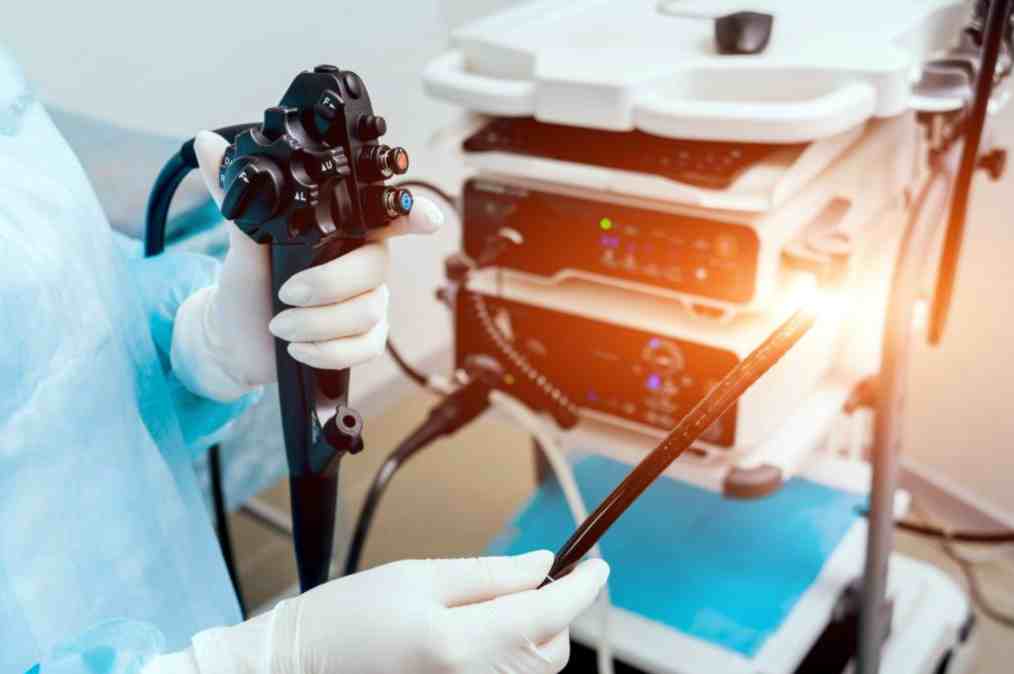
What is gastroscopy?
Gastroscopy is a diagnostic test in which a flexible tube with a video camera at the end is inserted through the esophagus, stomach and first part of the small intestine
Why is gastroscopy performed?
This test is performed to investigate some symptoms, such as pain, nausea, heartburn, difficulty swallowing.
During the procedure it is possible to perform biopsies which consist in the collection of tissue samples and are performed for the search for infections, the verification of the good functioning of the intestine and the diagnosis of abnormal-looking tissues, which can reveal pathologies such as celiac disease and pre-tumor or tumor lesions.
Treatment procedures such as distention of an area with a narrowing, removal of polyps (generally benign findings), or treatment of digestive bleeding may also be performed during gastroscopy.
What happens during the procedure?
Your doctor might start by squirting a local anesthetic spray down your throat.
Most patients are sedated, although endoscopy can also be done without any sedation if preferred.
During the procedure, the patient remains lying on his left side.
The endoscope is introduced into the digestive tract and does not interfere with breathing.
The exam lasts 5-10 minutes.
What happens after the procedure?
The patient is monitored until the effects of the sedative disappear.
Eventually it will be possible to eat something, unless your doctor gives you different instructions.
The patient should be accompanied home and not have to drive or make important decisions until the next day, as judgment and reflexes may be slowed due to the sedative drug administered.
What are the possible complications of gastroscopy?
Although complications are possible for this test, they are rare (less than 0.05%).
Perforation occurs with a maximum frequency of 0.03% and is generally linked to the presence of particular anatomical conditions (esophageal strictures, Zenker’s diverticulum, neoplasms).
In the case of operative gastroscopy (dilatation of strictures, polypectomies, haemostasis of bleeding lesions, ligation of oesophageal and/or gastric varices, positioning of prostheses or nutritional tubes) there is a higher risk of complications (0.5 – 5%).
Bleeding may occur at the site of the biopsy or removal of a polyp, but it is often a non-significant phenomenon, generally controllable endoscopically, which only in very rare cases may require surgery or a blood transfusion.
Some patients may have cardiorespiratory complications related to the use of sedatives, or complications due to heart or lung disease.
Death is an extremely rare event in endoscopic procedures.
Read Also
Emergency Live Even More…Live: Download The New Free App Of Your Newspaper For IOS And Android
Esophagogastroduodenoscopy (EGD Test): How It Is Performed
Symptoms And Remedies Of A Gastro-Oesophageal Reflux Cough
Gastro-Oesophageal Reflux Disease (GERD): Symptoms, Diagnosis And Treatment
Indigestion Or Dyspepsia, What To Do? The New Guidelines
Dyspepsia: What It Is, Symptoms, Diagnosis And Treatment
Gastro-Oesophageal Reflux: Symptoms, Diagnosis And Treatment
Functional Dyspepsia: Symptoms, Tests And Treatment
Straight Leg Raise: The New Manoeuvre To Diagnose Gastro-Oesophageal Reflux Disease
Gastroenterology: Endoscopic Treatment For Gastro-Oesophageal Reflux
Oesophagitis: Symptoms, Diagnosis And Treatment
Asthma, The Disease That Takes Your Breath Away
Gastroesophageal Reflux: Causes, Symptoms, Tests For Diagnosis And Treatment
Global Strategy For Asthma Management And Prevention
Paediatrics: ‘Asthma May Have ‘Protective’ Action Against Covid’
Esophageal Achalasia, The Treatment Is Endoscopic
Oesophageal Achalasia: Symptoms And How To Treat It
Eosinophilic Oesophagitis: What It Is, What The Symptoms Are And How To Treat It
Gastroesophageal Reflux: Causes, Symptoms, Tests For Diagnosis And Treatment
Irritable Bowel Syndrome (IBS): A Benign Condition To Keep Under Control
What Is Esophagogastroduodenoscopy?


